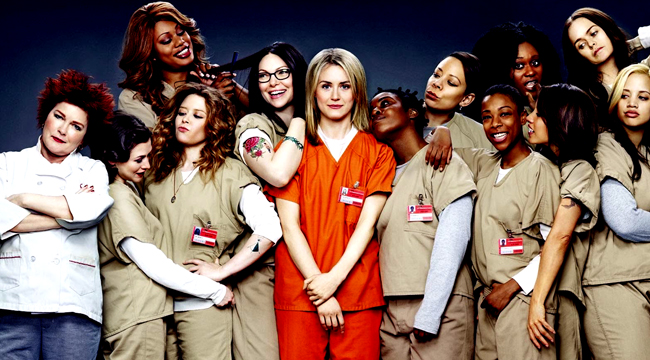
The last season of Orange Is The New Black was, to say the least, an unpleasant affair. Following Poussey’s unjust death at the hands of a corrections officer, Litchfield found itself the setting of a full-scale riot. By the end of the 13 episodes — which covered only about three days — dynamics drastically shifted, two guards were dead, and viewers were exhausted. The writers’ intentions were clear, and somewhat admirable, but it cast too wide of a net and kept spiraling — sometimes into agonizing depths.
Although Orange has always been a dark show, something shifted after Poussey. The storyline, written by an overwhelmingly white writers room, capitalized on black trauma and did a disservice to Black Lives Matter. Season five’s literally tortuous “The Reverse Midas Touch” was the most disturbing of the series’ run — I wouldn’t be surprised if people checked out. Going into season six, the question becomes, “How the hell is Orange going to fix itself after that?”
The answer is by attempting to go back to its roots. Season six, which premieres Friday, feels far more like the first two seasons than the last two. It’s still quite messy (as we’ve come to expect from a show that’s constantly trying to do so much with so many characters) and there’s a great deal of it that doesn’t work, but fortunately there’s also some success. For one, many of the episodes better navigate the darkly comedic tone (last season felt largely humorless), starting with some inventive scenes in the premiere. It’s scaled back in terms of scope and cast (a handful of inmates, such as Maritza and the druggy duo of Leanne and Angie, were sent off to different prisons). Much of the season focuses on a smaller group: the handful of “riot girls” who were shipped down the hill to the maximum security facility.
Even two of the season’s biggest and most captivating long-arcs feel simultaneously high stakes but smaller scale: the investigation into specifics of the riot/Piscatella’s death, and Taystee (Danielle Brooks) facing a harsh sentence while also becoming a cause for the ACLU. Taystee easily gets the best plot, a smart idea considering Brooks’ pitch-perfect, heartbreaking performance continues to reach new heights. It’s the plot with the most emotional investment but, true to Orange nature, it’s too-often used in relation to the people around Taystee (such as Nick Sandow’s Caputo and his inner turmoil) when it should stay on her.
What’s also successful is the show’s new setting and new characters. Life in “max” is jarring and less forgiving than the “summer camp up the hill,” which highlights how the women had gotten used to their prison lives before forcing them to uncomfortably adjust. The rules are different, as is the hierarchy, and there are dire consequences if you don’t buy in. It’s harsher: when Red (Kate Mulgrew) gives one of her intimidating sermons about the strength of her family — “We have iron wills. We have patience. We have sharp minds and deep reserves of power” — her new cellmate is nonplussed. “Great speech,” she sarcastically responds.
As some of the women slowly return to the general population, they’re separated into different blocks (such as “C” and “D”) that already have established gang rivalries. Each block is led by either of two sisters with decades of hatreds toward each other. The sisters, Barb (Mackenzie Phillips) and Carol (Henny Russel) are the best newbies, perfectly weird, vicious, and bleakly humorous. The flashback device is rarely used and largely inconsequential this season, but Barb and Carol’s is darkly delightful enough that it’s welcome. (Another good flashback goes to Taystee and a new guard whom she knows from her old life.)
Other new additions range in quality from the slick Daddy (Vicci Martinez) who takes a special interest in Daya (Dasha Polanco) though unfortunately in an unoriginal plot, to the yawn-inducing Madison “Badison” Murphy (Amanda Fuller) an annoying rival that feels overdone. (The grating Boston accent doesn’t help matters.) Thankfully, Orange devotes time to old crew: Pennsatucky (Taryn Manning), who escaped at the end of last season, has a solid story; the lovely Flaca (Jackie Cruz) gets an amusing new sidekick; Suzanne (the great Uzo Aduba) remains one of the most affecting of them all; Piper (Taylor Schilling) remains a fun character to groan at, and eventually gets a good plot; and Cindy (Adrienne C. Moore) gets to balance her pain with comic relief.
Of course, Orange keeps devoting (perhaps too much) time to the Litchfield guards with its usual mixed results, such as the PTSD plot given to McFullough (Emily Tarver), which is somewhat interesting but doesn’t land. Another long arc, which I’m not allowed to spoil here, emphasizes some of the guard’s not-exactly-new sadistic tendencies. Like always, Orange wants to cover a lot of ground in terms of for-profit prison systems and everything — and everyone — tangentially attached to them. It also has endless to say about hope and suffering and humanity, and all of those words we usually attribute to it. But these high ambitions means it sometimes falls under its own weight.
At least, there’s an overall feeling that Orange Is The New Black is finally beginning to wrap things up (it’s been renewed for a seventh season, which I hope is the last), a good decision since its best days are clearly behind it. Yet it’s definitely — especially for early fans — something that’s still worth watching, and tells so many stories that deserve to be told. There’s a lot of stumbling throughout, but there are glimmers of its old spirit.
‘Orange is the New Black’ returns to Netflix for its sixth season on July 27.






